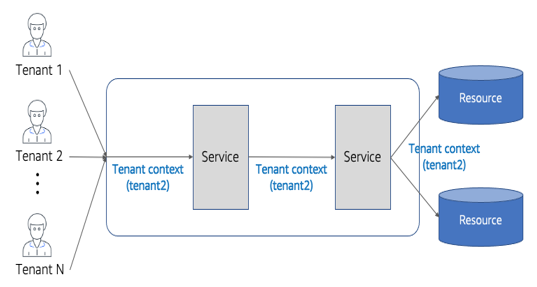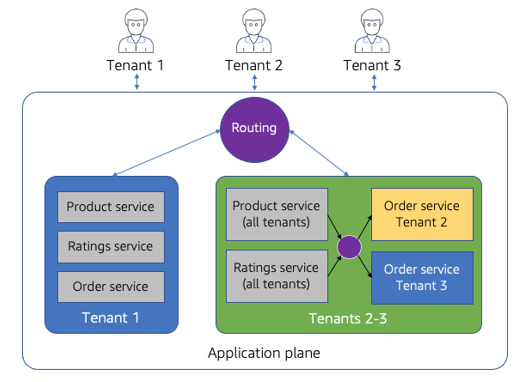Inside the Application Plane
Now that we have a better sense of the core concepts with the control plane, let’s start looking at the common areas where multi-tenancy shows up in the application plane. While the control plane typically has a consistent set of common services, the application plane is a bit more abstract. How and where multi-tenancy is applied within the application plane can vary significantly based on a wide range of factors. That being said, there are still a range of themes that will surface, albeit in different forms, within your application plane. So, even though there is variation here, every SaaS architect will need to consider how/where they will introduce these themes into the application plane of their solution.
As you dig into the application pane, you’ll find that your technology stack and deployment footprint will have a significant influence on how these concepts are applied. In some cases, there may be ready-made solutions that fit your use case precisely. In other cases, you may find yourself inventing solutions to fill gaps in your technology stack. While building out something to fill these gaps may add complexity and overhead to the build of your solution, in most cases you’ll want to take on this added work to ensure that your SaaS solution is not compromising on important elements of your multi-tenant architecture.
In subsequent chapters we’ll look at real-world working examples that provide a more concrete view of how these constructs are realized within your application plane. For now, though, let’s come up a level and establish a core set of application plane principles that should span every SaaS architecture.
Tenant Context
One of the most fundamental concepts in our application plane is the notion of tenant context. Tenant context does not map to any one specific strategy or mechanism. Instead, it’s a broader concept that is meant to convey the idea that our application plane is always functioning in the context of specific tenants. This context is often represented as a token or some other construct that packages all the attributes of your tenant. A common example that you’ll use here is a JSON Web Token (JWT) which combines your user and tenant information in one construct that is shared across all the moving parts of your multi-tenant architecture. This JWT becomes our passport for sharing tenant information (context) with any service or code that relies on this context. It’s this token that is referred to as your tenant context.
Now, you’ll see that this tenant context has a direct influence on how your application architecture processes tenant requests. This may affect routing, logging, metrics, data access, and a host of other constructs live within the application plane. Figure 2-6 provides a conceptual view of tenant context in action.

Figure 2-6. Applying tenant context
The flow in Figure 2-6 shows tenant context being applied across the different services and resources that are part of a multi-tenant environment. This starts on the left-hand side of the diagram where my tenants authenticate against the identity that was created during onboarding and acquire their tenant context. This context is then injected into a service of my application. This same context flows into each downstream interaction of my system, enabling you to acquire and apply that context across a range of different use cases.
This represents one of the most fundamental differences of a SaaS environment. Our services don’t just work with users–they must incorporate tenant context as part of the implementation of all the moving parts of our SaaS application. Every microservice you write will use this tenant context. It will become your job to figure out how to apply this context effectively without adding too much complexity to the implementation of your system. This, in fact, is a key theme that we’ll address when we dig into SaaS microservice in Chapter 8.
As a SaaS architect, this means that you must be always thinking about how tenant context will be conveyed across your system. You’ll also have to be thinking about the specific technology strategies that will be used to package and apply this tenant context in ways that limit complexity and promote agility. This is a continual balancing act for SaaS architects and builders.
